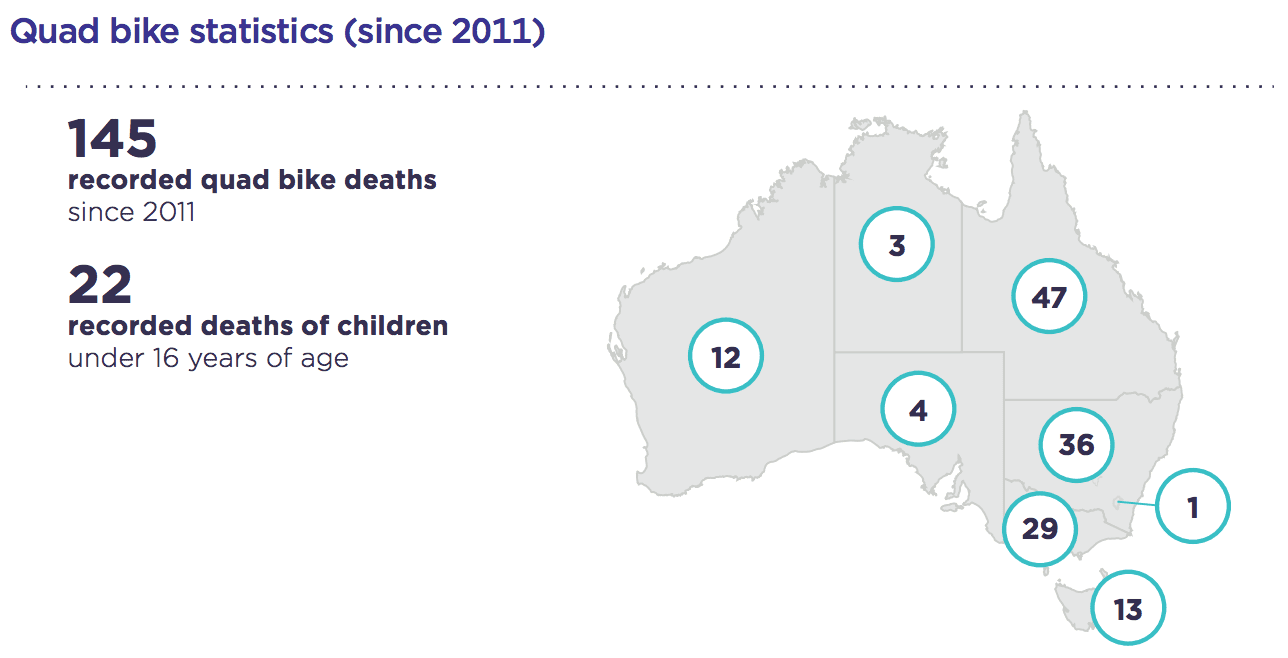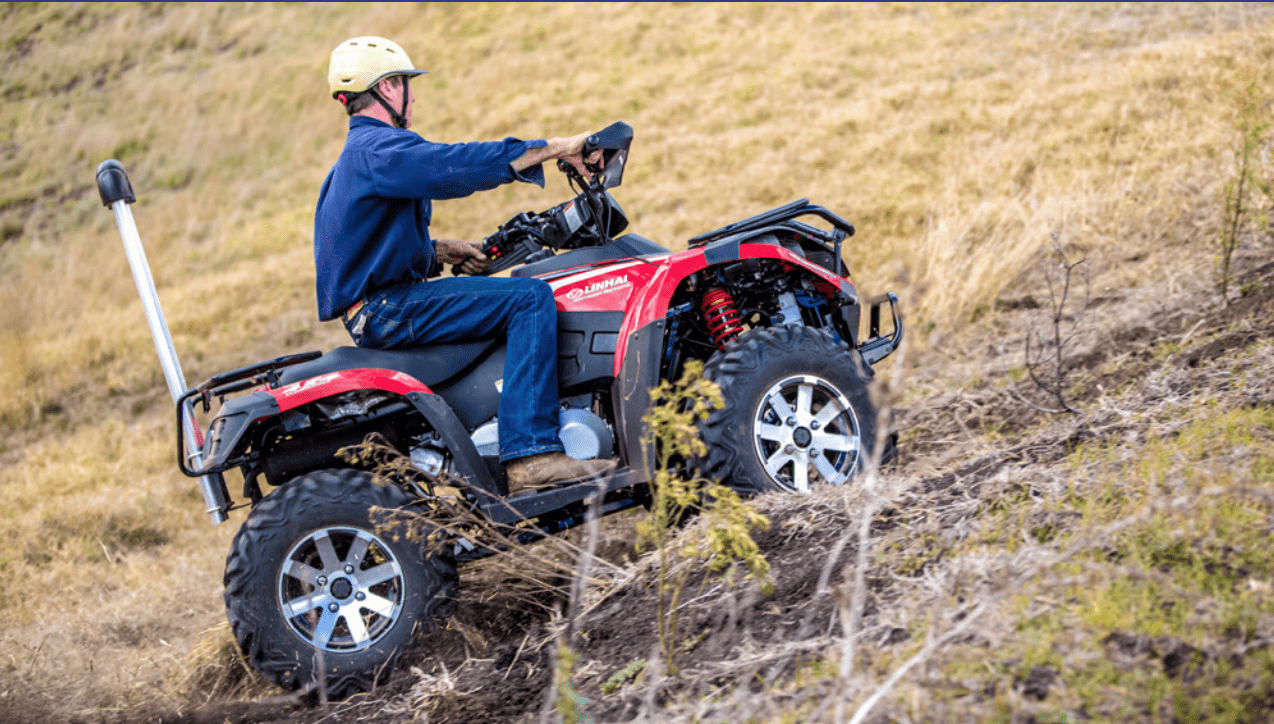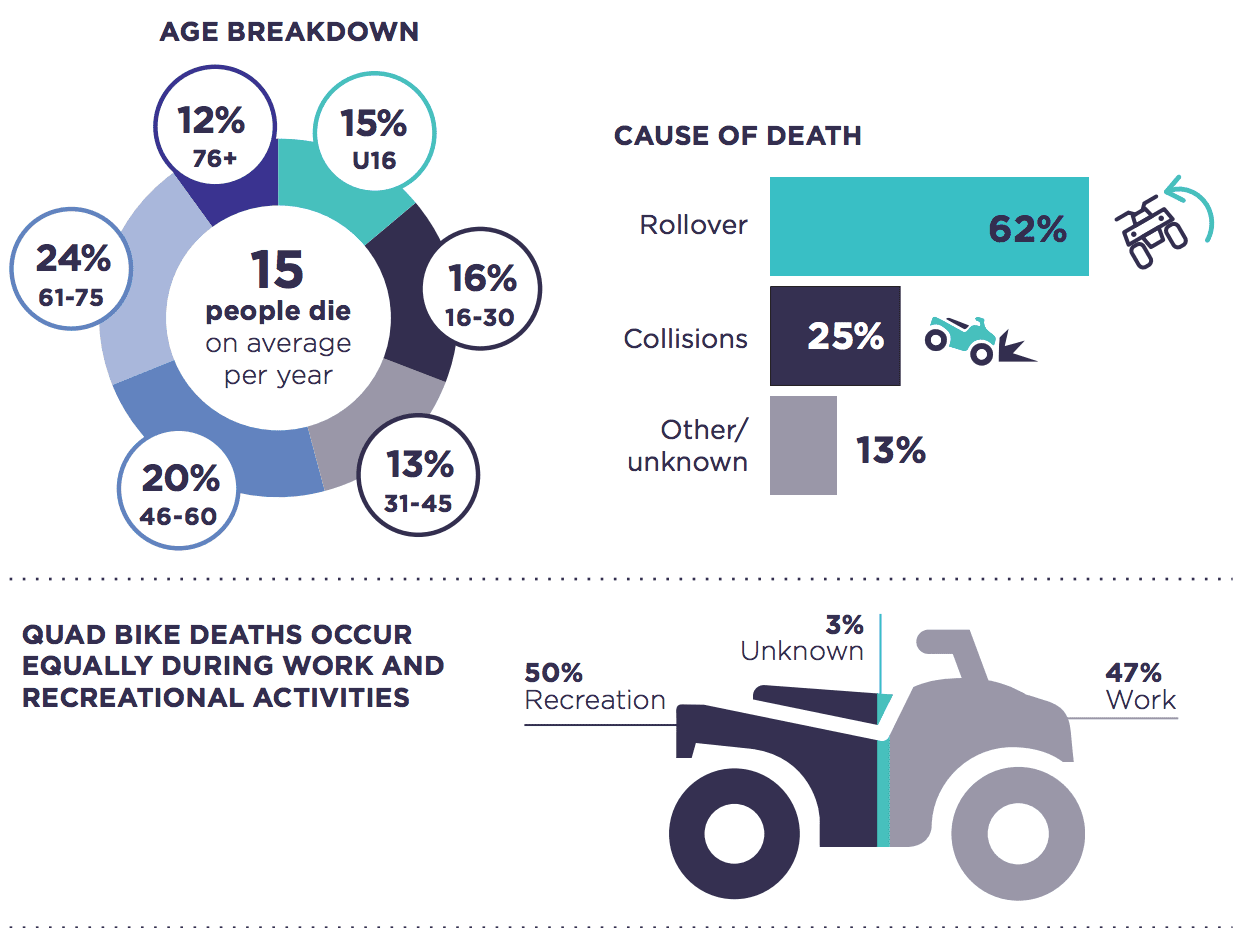IN LESS than one hundred days, the first stage requirements of the new quad bike safety standard will become mandatory in Australia.
In my position as Deputy Chair of the ACCC, with responsibility for small business and agriculture, I have been closely involved in the development of this new safety standard.
The standard was the result of two years of intensive investigation by the ACCC, which included input from Australian and international experts, overseas government agencies, and multiple industry consultations.
The standard was the result of a very rigorous process, and is squarely designed to save lives.
The sombre and irrefutable fact is that quad bikes are the single biggest killer on Australian farms.
 Since 2011, 150 people have died as a result of quad bike accidents. 23 of those have been children.
Since 2011, 150 people have died as a result of quad bike accidents. 23 of those have been children.
And so far this year, there have already been 14 reported fatalities – almost double the figures reported last year.
There are inherent dangers associated with the current design of quad bikes and the way the death toll continues is simply unacceptable.
Australia recently marked Farm Safety Week. It’s timely to remind people about the risks of quad bikes, how to use them safely, and why the government’s new safety standard is so important.
Our research, which came from coronial reports, work health and safety and hospital data, revealed most people die or are injured on quad bikes due to crush injuries or asphyxiation, which occur when a quad bike rolls over the rider, or comes to rest on top of them.
The information the ACCC obtained during its investigation showed the priority for improving quad bike safety is addressing this risk of rollover, which is attributable for at least 60 per cent of quad bike fatalities in Australia.
That’s why next year the standard’s second stage introduces minimum stability requirements and makes it compulsory for new quad bikes to be fitted with an operator protection device (OPD).
An OPD alone will not stop all deaths and serious injuries, however, a quad bike with a properly designed and engineered OPD will help mitigate injury risk in the event of a rollover.
It does this by reducing the likelihood of the quad bike completely rolling over, or if it does by preventing the weight of the quad bike resting on the rider, by holding it off the ground and creating, in effect, a crawl out space or survival zone. Our investigation indicated an OPD, without any other regulatory intervention, may help to prevent around a third of all quad bike deaths in Australia.
As more evidence is gathered, the safety benefits from improving the design of quad bikes, including the fitting of OPDs, is being recognised by coroners, courts and work health and safety agencies.
Last year, the Victorian Coroner highlighted how such safety measures recommended by the ACCC can significantly reduce the frequency and severity of injuries, particularly from rollover incidents. State governments are also recognising the benefits, providing rebates for owners to fit OPD to quad bikes currently in use.
Other safety measures like wearing helmets, doing the appropriate training, and not allowing children to ride adult sized quad bikes, are also important in reducing fatalities, and the Australian Government is encouraging state governments to support these measures.
But we know education campaigns alone are not an effective long term solution, especially when quad bikes are inherently unsafe, and even very experienced riders have accidents with tragic consequences.
There have been some recent suggestions that side-by-side vehicles (SSVs) can pose similar dangers to quad bikes. SSVs by design, offer a greater level of protection than quad bikes as they are more stable, have a roll cage, seat belts, doors and nets that keep occupants inside the survival zone of the cage. Unfortunately, most fatalities involving these vehicles appear to be situations when these safety measures are not being used – in particular the wearing of seatbelts.
And while the new safety requirements for quad bikes won’t prevent all deaths – they will prevent many. These safety measures are the next steps in protecting lives in rural Australia, and surely that’s worth fighting for.
14 quad bikes deaths so far this year is shocking and we cannot stand by and allow it to continue.




Yet again more spin from Canberra driven largely by the National Farmers Federation (NFF). These are the facts:
– Yes people are killed on quad bikes, but the statistics show almost as many are killed on side-by-sides.
– Keogh’s ACCC submitted only 4 recommendations from an apparent ‘intensive’ investigation. Recommendation 1 – Do nothing, 2-4 – force manufacturers to fit Operator Protection Devices (OPDs). It took you 2 years Mick to punch out 4 recommendations mate? That’s called a stitch-up.
– Under the regulatory impact assessment process within Prime Minister and Cabinet, agencies like Mick’s are meant to assess the regulatory impact of legislation on communities. Guess what? Mick didn’t. In fact, the Minister himself indicated that Mick ‘self-certified’. In essence, Mick went to bed at night and made the decision that the social and economic ramifications didn’t matter.
– As a result, 228 rural and regional dealers will potentially close, losing thousands of jobs and an estimated $800M in lost revenue.
– The impact on other sectors is huge – motocross, enduro, adventure, ag bikes, pumps, accessories, transport etc.
– Just ask yourself: how hard is it already to secure parts and or a mechanic? How many more dealers, shops and service centres can rural Australia accept as closed and expect towns to thrive?
– Empirical research shows rural dealers derive up to 60% of their income from quad bikes. Metro dealers around 35-40%. This was never considered by Mick when he forced global manufactures to leave Australia.
– Coronial Inquest findings have shown that an OPD can in some instances and across some occupations, make the quad bike less safe. In fact, in one Coronial Inquest it was suggested that the rider may have survived if not for the OPD.
– Under State OH&S laws the PCBU – business owner / farmer – has an obligation to assess risk. Why wouldn’t you devise policy that allows a farmer to fit an OPD – it’s called choice – based on the use of that specific quad bike in certain on-farm jobs?
– Standards Australia walked away from Mick and the NFF. They will not design a technical specification for OPDs.
– AGFORCE walked away from Mick and the NFF.
– The beef sector walked away from Mick and the NFF.
– The motor trade sector walked away from Mick and the NFF.
– The dairy sector is close to walking away from Mick and the NFF.
– The mustering guys walked away from Mick and the NFF.
Now here is the kicker?
– If the NFF and Mick are so committed to on-farm safety, why does their position / decision / solution, not apply to the over 500,000 quad bikes currently in the system? What, do people only get hurt on new quad bikes Mick!!!! It’s a fair question.
Under our solution it’s not mandatory, but rather the farmer has the freedom to choose whether his quad bikes – old or new – are fitted with an OPD or not based on intended use and risk. This generates more revenue for dealers, keeps dealers open and keeps them employing. It also delivers a far greater overall outcome in terms of on-farm safety because an OPD is considered an after-market safety option, no different to a bash plate or bark buster. However, the NFF and Mick didn’t go down this road, instead they forced global manufacturers to fit an item to THEIR machine, that the scientific evidences suggests, could make the quad bike less safe in key circumstances. A risk they are not prepared to wear and we don’t blame them.
I just wonder how many more of these nanny state decisions can small and medium businesses accept whilst policy makers and Ag technocrats in Canberra expect businesses to remain profitable and employ Aussies. Keogh has failed on this one. And for what it’s worth – the greatest challenge facing agriculture in Australia isn’t commodity prices, water or China, but rather the NFF.
1. Keogh said a responsibility for small business and ag. This is not true as he has not taken in to account that he is treating farmers like test dummies with the OPD, plus farmers will become less efficient, plus small business and staff are going to suffer financially.
2. Keogh says 2 years of intensive including input from experts overseas. Not true , as ACCC did not take any notice of expert information submitted to them by the industry and FCAI.
3. Keogh says our research came from coronial reports. Not true. None of the coronial inquests suggested or stated that OPD’s would of prevented the deaths.
4. Keogh says an OPD with properly designed and engineered. Not true. The Quad bar is not designed by an engineer and has no specific standards to align with. The legislation still does not have specific requirements for an OPD.
5. Keogh says, the safety benefits of OPD’s are being recognized by coroners. Not true.
6. Keogh spoke about SSV deaths briefly. he did not mention that the number of SSV’s in Australia are only 10% of the number of quad bikes in Australia, and in 2019 there was already equal deaths on SSV’s as quad bikes. This makes SSV;s 1000% more dangerous than a quad based on the numbers. The other thing he did not mention, is that there were 4 farm deaths on quad bikes, 4 recreational deaths on quad bikes with one of them being a child, and 8 deaths on SSV’s with 4 of them being children . Yes not wearing seat belts on SSV;s was the problem, but also under 16 year olds are not allowed to operate quad bikes or SSV’s yet 31% of the reported 16 quad deaths were children. If we could keep children off all machines, and make people wear seat belts on SSV’s, and not include recreational quads in the numbers, as this is about farm accidents, then that is a 75% reduction in supposed quad bike deaths.
7. The answer to this problem is licensing for quad bikes and SSV’s, just like a forklift or a chainsaw, national marketing campaigns on the dangers of allowing children to use these machines, as well as licensing, wearing seat belts and helmets and possible conditional registration. This would save lives by only having licensed riders riding them, plus it would safe gaurd farmers from litigation by having all things like licensing , underage riders, helmets etc in place.
Considering how many ATV’s are on properties Australia wide the total recorded ATV related death figure is quite frankly low. on our property our employees spend at least two hours every day on ATV’s and as property owners know sometimes you don’t seem to get off them all day. it is noted that as many deaths are related to tractors and heavy farm equipment, all of which farm employees are trusted to be in control of on a daily basis.
our business would have to spend a substantial amount of money on new plant to allow us to transport the utv’s (ssv’s) from one property to another. We are able fit a couple of atvs on a utility alone and another two across a box trailer if needed.
having worked also on cattle stations and seeing how some bikes are ridden and treated its quite frankly a miracle there are not more accidents or deaths. Every year the center of gravity is being lowered and the wheelbase steadily widened by the manufacturers which is making these bikes far safer than they ever used to be.
It seems those in control of this legislation have made up their minds before looking to those on the land. there is a reason the main manufacturers will not fit these “safety features” to their bikes from factory, they are not safe! we are all aware of imminent hookups in trees and god help anyone that goes over the handlebars with a solid roll bar fitted.
Atv’s are not suited to everyone but they are irreplaceable for others like ourselves, we have just purchased a fleet of new ones and are not looking forward to when we will have to replace them.